A conveyor installation includes a drive wheel, as is the case with power transmission.
The force applied to the chain comes from the weight of the load being carried and the friction it causes, and from the chain itself.
A conveyor installation includes a drive wheel, as is the case with power transmission.
The force applied to the chain comes from the weight of the load being carried and the friction it causes, and from the chain itself.
The chain can be supported between the wheels in a variety of ways:
► the chain slides over a guide resting on the edge of its plates
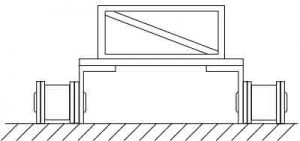
► the chain runs over a guide resting on its rollers or more usually on its straight or shouldered rollers
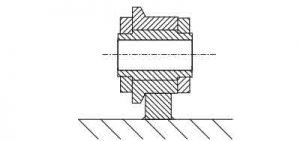
► The chain is supported by one or more idler wheels that may either be smooth or toothed resting on the edge of its plates or on its rollers. This configuration is only used for the slack strand. The chain supports at the level of the taut strand and of the slack strand are not necessarily identical.
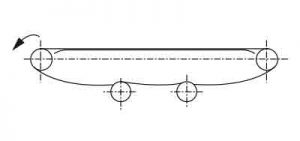
In the case of a vertical installation, it may be possible to do without any support or guidance for the chain which, in this case, is hanging from the upper wheel, which is usually the driving wheel.
The loads carried can be of very different types, which means there is a very great variety of conveyor installations:
► the load is continuous over the whole length of the conveyor belt, and it is:
• loose (coal, grain, etc.)
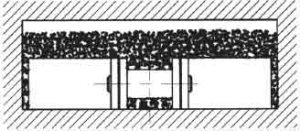
• distinct objects in contact with each other (cardboard boxes, cases, etc.)
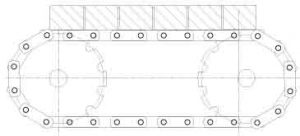
► the load is discontinuous. It consists of objects spread more or less regularly along the conveyor belt
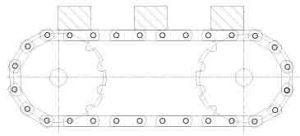
Independently from the nature of the load, it may be supported in different ways when being transported:
► the load is not supported by the chain, which then only provides traction. The load rests on a guidance surface on which it slides or rolls. This is most commonly found in the case of loose product being transported in a chute, in which the chain is embedded.
► the load is supported by the chain:
• either directly, generally by means of offset plates,
• or by means of various accessories attached by means of one of the methods described in the previous paragraph (hollow pins, holed plates, K attachments, etc).
The origin of the value of the forces exerted on the chain depends not only on the means used to support the chain and to support the load, but also on the nature of the route it takes:
► Straight horizontal route (the simplest case):
In principle the traction forces on the chain are only caused by friction:
• sliding and/or rolling of the chain’s two strands on its guides,
• possible friction of the load on its supports,
Furthermore the chain is loaded perpendicularly to its direction by the weights (chain and load). This force may be exerted on the rollers.
► Straight sloping route: the above-mentioned forces must be weighted:
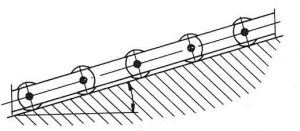
• in addition to the friction there is the increase in weight,
• the weight is only exerted by its normal component.
► Curved route: the laws of mechanics make it possible to calculate the effect of the guide’s curvature on the chain’s friction. This must only be taken into account for small curve radiuses and significant deviations.
► Combined route: any given installation may of course include sectors that combine the configurations described above.
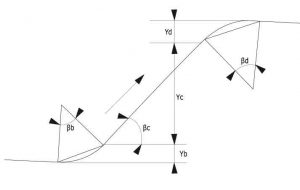
There may be different working conditions besides the basic conditions described above. They must be taken into account when describing the chain’s utilization conditions (next paragraph). This essentially concerns not only mechanical parameters, but also the nature of the environment.
► Drag: an additional force is exerted on the chain when the conveyor’s load is dragged, as is often the case with bucket elevators.
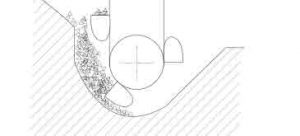
► Jolts: independently from the jolting that may occur at startup, the arrival of loads on a conveyor in operation may also cause overloading, which must be taken into account.
► Torsion : the forces exerted on the chain must not have any torsion component, but it is not always possible to avoid this completely. It must then be taken into account.
► Polygonal effect: when the wheel does not have many teeth, which is often the case regarding conveyor, their polygonal shape causes transversal oscillations and speed variations that may cause overloading and be prohibitive under certain conditions.
► Speed: as the weights in movement are generally high, the average value of the chain’s speed and the variations in this speed are important parameters. The table below gives the values commonly used for the main types of conveyor chain utilization.
| Wood or metal pallet conveyors | 0,10 à 0,50 m/s |
| Spaced vertical bucket elevators | 0,60 à 1,75 m/s |
| Spaced inclined bucket elevators | 0,60 à 0,95 m/s |
| Continuous vertical bucket elevator | 0,30 à 0,70 m/s |
| Continuous inclined bucket elevator | 0,15 à 0,40 m/s |
| Strip conveyor belts | 0,10 à 0,60 m/s |
| Suspended swing-tray elevator | 0,10 à 0,30 m/s |
| Scraper conveyor belt | 0,20 à 0,50 m/s |
► Environment: it is quite common to have conveyor chains operating in a difficult environment. This generally concerns chemical aggression (humidity, acid vapors, etc) and the temperature conditions (high or low). See paragraph 2 for the recommended treatments.